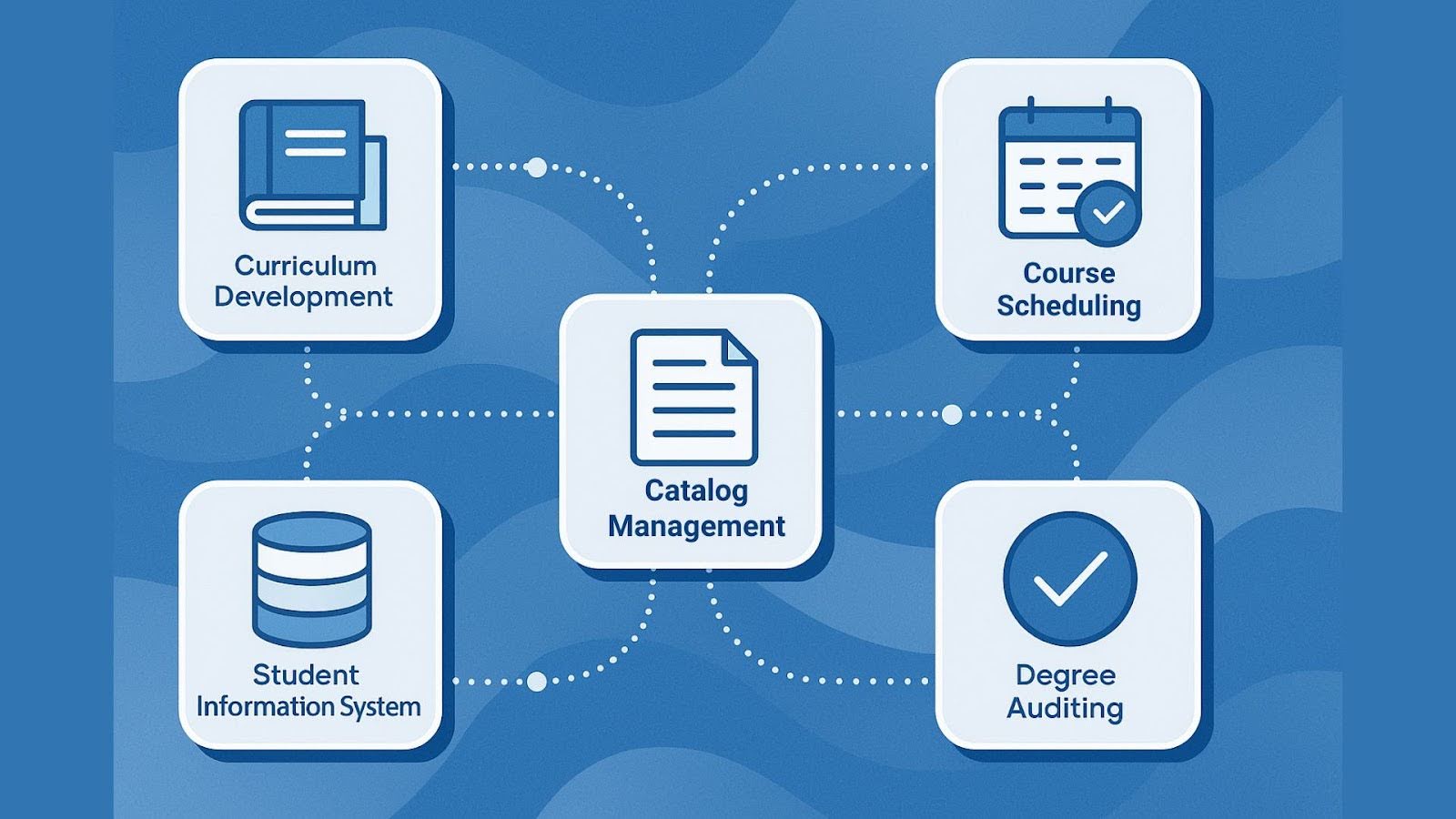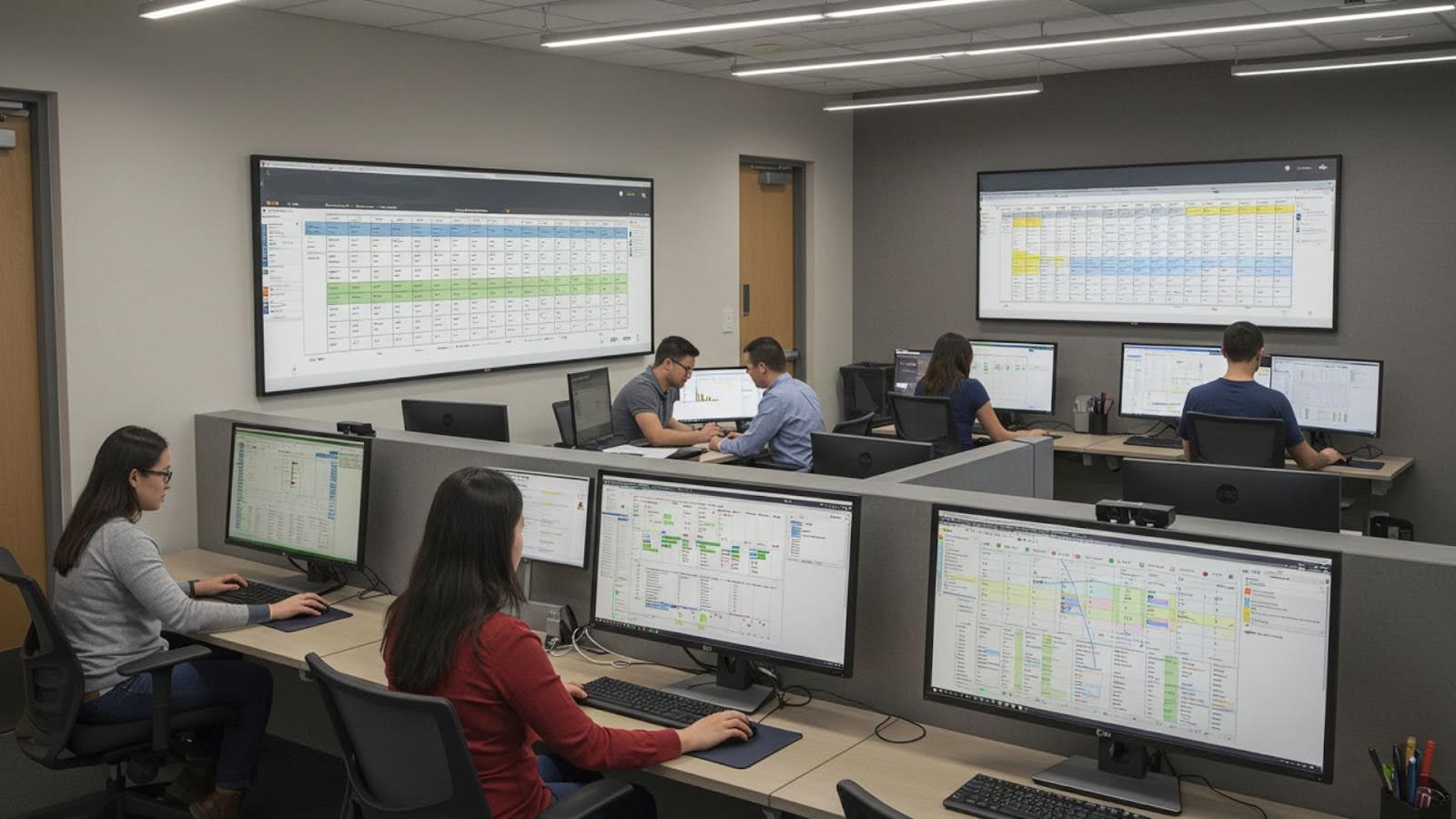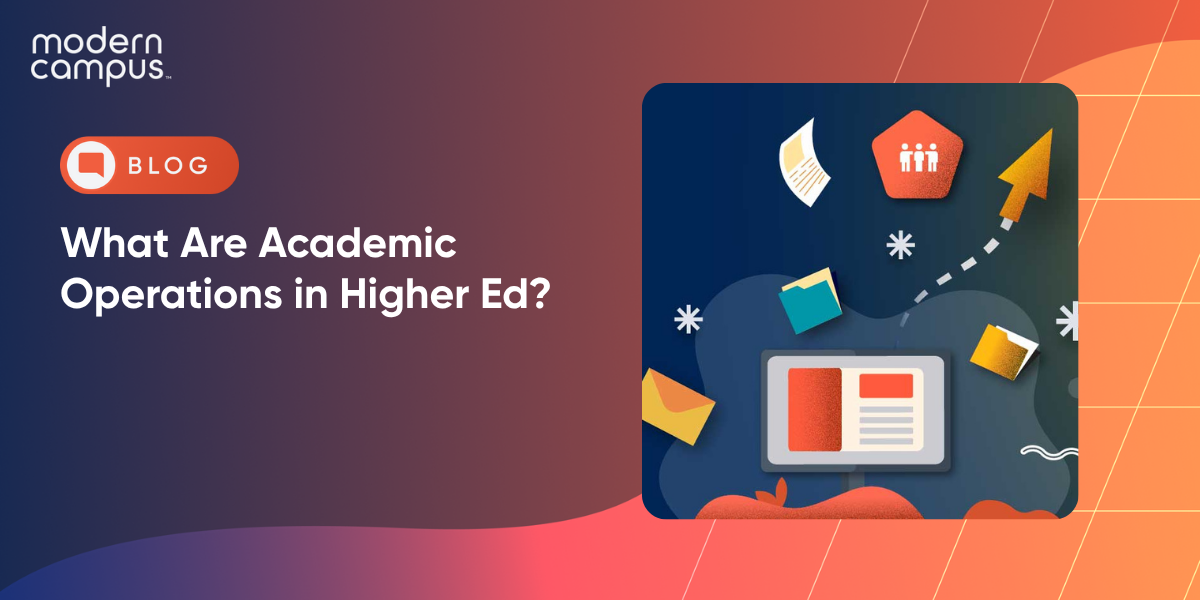What Are Academic Operations in Higher Ed?
Higher education institutions across North America are navigating unprecedented challenges. Financial pressures have intensified, with an average of one college per week announcing closure or merger throughout 2024. Yet behind these headline-grabbing statistics lies a more fundamental issue: many institutions are still running critical academic operations through manual, outdated processes that drain resources and frustrate both staff and students.
Academic operations form the backbone of every successful institution, encompassing everything from curriculum development to course scheduling, catalog management and student progress tracking. These processes directly impact whether students can access the courses they need, graduate on time and achieve their career goals. Modern institutions are increasingly recognizing that streamlined academic operations create competitive advantages that benefit all stakeholders.
Understanding Academic Operations in Higher Education
Academic operations represent the comprehensive system of processes, policies and procedures that enable institutions to effectively deliver education. These interconnected systems bridge the gap between institutional strategy and daily execution, ensuring that educational programs align with student needs, faculty capabilities and institutional resources.
Core Definition and Scope
Higher ed operations encompass how curriculum is created, approved, scheduled and delivered to students throughout their educational journey. Academic operations power the entire educational experience. While faculty focus on teaching and research and students concentrate on learning, academic operations ensure that all the behind-the-scenes logistics work seamlessly.
The scope extends beyond simple administrative tasks. Academic operations provide the foundation that enables institutions to adapt quickly to changing demands while maintaining academic quality and regulatory compliance. They include managing course catalogs, coordinating class schedules, tracking degree requirements and maintaining the complex web of data that connects every aspect of a student's academic life.
Key Stakeholders and Departments Involved
Effective academic operations require collaboration across many teams—including registrars, academic affairs teams, department chairs, faculty members, administrative support staff, IT departments and institutional research teams. Each group brings unique perspectives and requirements, from registrars managing compliance to faculty shaping curriculum design.
Students themselves are increasingly viewed as key stakeholders whose feedback and enrollment patterns inform operational decisions. Research shows that institutions focusing on student engagement throughout the educational journey see significantly higher persistence and retention rates.
How Academic Operations Impact Student Success
The connection between efficient operations and student outcomes runs deeper than many institutions realize. Effective scheduling processes ensure that required courses are offered frequently enough and at times that accommodate diverse student needs. Clear, accessible catalog information helps students make informed decisions about their academic pathways, particularly benefiting first-generation college students.
When advisors have access to comprehensive, real-time data about student progress, course availability and program requirements, provides more personalized guidance. Students receive timely interventions and clearer direction about optimal course sequences when they're at risk of falling behind.

5 Essential Components of Academic Operations
Modern academic operations encompass five critical areas that work together to create seamless educational experiences. These components must integrate effectively to support both student success and institutional efficiency. Understanding how each element contributes to the overall system helps administrators identify improvement opportunities and prioritize technology investments.
1. Curriculum Development and Approval Workflows
Curriculum development represents one of the most complex aspects of academic operations, involving multiple review stages, stakeholder input and approval processes. It typically begins with market analysis and educational needs assessment, progressing through department-level reviews focusing on academic content and college-level committees examining strategic alignment.
Documentation and communication throughout these workflows pose significant challenges for many institutions. Traditional paper-based or email-driven processes can result in lost proposals, unclear approval status and lengthy delays. Modern approaches emphasize transparent, digital workflows that provide real-time visibility into approval progress and maintain comprehensive audit trails for accreditation purposes.
2. Course Catalog Management and Publication
The course catalog serves as both a legal document and a marketing tool, making accurate, timely catalog management critical for institutional success. Catalog management involves coordinating information from multiple sources and ensuring consistency across all institutional communications.
Digital catalog systems enable more responsive update processes while maintaining version control and historical records. These systems can integrate with other academic operations tools, automatically updating course information when scheduling or curriculum changes occur, reducing manual data entry and ensuring consistency across all student-facing communications.
3. Class Scheduling and Resource Allocation
Class scheduling represents one of the most visible aspects of academic operations, directly impacting student access to education and institutional resource utilization. Traditional scheduling approaches often operate in departmental silos, resulting in scheduling conflicts, suboptimal room utilization and limited flexibility for students with complex needs.
Effective course scheduling systems emphasize institution-wide coordination and data-driven decision making. Predictive analytics help institutions understand enrollment patterns and student demand, enabling proactive scheduling decisions that reduce bottlenecks and improve student access to required courses.
4. Student Information Management
Comprehensive student information management provides the data foundation that enables effective decision making and student support. Student information systems must accommodate the complexity of modern higher education, where students frequently change majors, pursue multiple credentials and follow non-traditional academic pathways.
Integration between student information systems and other academic tools enables more responsive student support. When advisors can access real-time information about course availability, degree progress and academic history in a unified interface, they can provide more timely and accurate guidance while students benefit from self-service access to their academic information.
5. Degree Audit and Compliance Tracking
Degree audit processes ensure that students meet all graduation requirements while helping institutions maintain compliance with accreditation standards. Automated degree audit systems provide real-time analysis of student progress against degree requirements, identifying missing courses and potential substitution opportunities.
Compliance tracking encompasses programmatic and institutional obligations. Academic operations systems can monitor graduation rates, credit hour requirements and other metrics required for accreditation reporting, reducing administrative burden while providing ongoing visibility into institutional performance.

Common Academic Operations Challenges
Institutions face numerous obstacles when managing academic operations through traditional methods. These challenges compound over time, creating inefficiencies that impact both institutional effectiveness and student success.
Manual, time-consuming processes dominate many institutions' operations. Curriculum approval workflows that rely on paper forms and email communications can take months to complete, delaying program updates that could benefit students.
Siloed systems and data inconsistencies create confusion across departments. When scheduling systems don't communicate with student information systems, discrepancies arise between advertised course offerings and actual availability.
Delayed catalog updates and approvals frustrate students and advisors who need current information for academic planning decisions. When catalog information doesn't reflect current course offerings, students may plan academic pathways based on outdated information.
Scheduling conflicts and resource optimization challenges result in suboptimal utilization of institutional resources. Classrooms may sit empty during peak demand periods while students struggle to access required courses.
Limited visibility into student progress prevents early intervention when students encounter academic difficulties. Without real-time access to comprehensive student information, advisors may miss opportunities to provide timely support.
How Technology Transforms Academic Operations
Modern technology eliminates many bottlenecks that plague traditional institutional processes while providing new capabilities for data analysis and student support. Integrated platforms enable real-time collaboration, automated workflows and comprehensive visibility into institutional performance. The transformation requires careful planning but delivers measurable improvements in efficiency and student satisfaction.
Automated Workflow Management
Modern technology eliminates manual bottlenecks through automated workflow systems that route curriculum proposals through appropriate approval channels based on predefined rules. These systems provide real-time visibility into approval status and automated notifications that alert reviewers when input is needed.
The global higher education technology market is projected to reach $116.71 billion by 2033, driven largely by institutions' need to streamline operations and improve efficiency through automation.
Real-Time Data Integration and Analytics
Integrated academic operations platforms provide comprehensive visibility into institutional performance through real-time data analysis. Predictive analytics capabilities help institutions anticipate future challenges by analyzing historical enrollment patterns to identify courses likely to experience high demand.
Data integration also enables more sophisticated analysis of student success patterns. Institutions can identify early warning indicators that predict student difficulties and implement targeted interventions. Understanding which course sequences lead to optimal outcomes helps advisors guide students toward successful pathways.

Student Self-Service Capabilities
Modern systems empower students to take greater ownership of their educational journey through comprehensive self-service capabilities. Students can access real-time information about course availability, degree progress and academic requirements without waiting for advisor appointments.
Self-service degree audit tools help students understand graduation requirements and explore alternative pathways that might accelerate their progress. These capabilities reduce administrative burden on staff while providing students with greater control and transparency over their academic decisions.
Best Practices for Streamlining Academic Operations
Successful higher ed operations modernization requires strategic planning, stakeholder engagement and attention to change management. Institutions that systematically approach transformation see better adoption rates and more sustainable improvements. The following practices help ensure that operational changes deliver lasting benefits for students, faculty and administrators.
Establishing Cross-Departmental Collaboration
Effective academic operations require breaking down traditional departmental silos and fostering collaboration across organizational boundaries. Successful institutions establish cross-functional
teams that include representatives from academic affairs, registrar services, information technology and student services.
Modern curriculum management approaches emphasize cross-departmental collaboration and shared accountability for student outcomes. Regular communication channels ensure that operational decisions consider multiple perspectives and potential impacts, while shared performance metrics encourage departments to work toward common goals.
Implementing Data-Driven Decision Making
Leading institutions leverage comprehensive data analysis to inform academic operations decisions rather than relying solely on tradition or intuition. Key performance indicators should align with institutional mission and student success goals, including metrics like time to graduation, course availability rates and student satisfaction with academic services.
90% of higher education leaders believe that data-driven decision making is crucial for institutional success. Data transparency helps build buy-in for operational changes.
Modernizing Legacy Systems and Processes
Many institutions operate academic functions through systems designed for earlier eras of higher education. Modernization efforts should prioritize areas where technology can provide the greatest impact on student success and operational efficiency through phased implementation approaches that reduce risk while providing early wins.
Institutions that effectively manage scheduling challenges often see immediate improvements in both operational efficiency and student satisfaction. Change management considerations are crucial for successful modernization, requiring adequate training and support to help staff adapt to new systems and processes.
Transform Your Institution's Academic Operations
The institutions that thrive in today's environment will be those that embrace modern approaches to academic operations. By implementing integrated systems that automate routine tasks, provide real-time visibility into student progress and enable data-driven decision making, colleges and universities can create competitive advantages that benefit all stakeholders.
The benefits compound quickly. Students experience fewer barriers to academic progress, faculty spend more time on value-added activities and administrators gain the insights they need to optimize institutional performance. Most importantly, efficient academic operations enable institutions to fulfill their core mission more effectively: helping learners develop the knowledge and skills they need for successful careers.
Modern Campus empowers over 1,700 higher education institutions to streamline their academic operations and deliver exceptional student experiences through course catalog management, class scheduling and comprehensive student information systems. Request a demo today to discover how we can help your institution achieve operational excellence.
Frequently Asked Questions
What departments are typically involved in academic operations? Academic operations involve multiple departments, including the registrar's office, academic affairs, scheduling services, enrollment management, IT and academic departments. Faculty, advisors and students also play key roles as stakeholders who both influence and are impacted by academic operations processes.
How do efficient academic operations improve student retention? Streamlined academic operations reduce barriers to student success by ensuring course availability, providing clear degree progress information and enabling timely interventions when students encounter difficulties. When students can easily access required courses and understand their path to graduation, they're more likely to persist and complete their degrees.
What's the difference between academic operations and student services? Academic operations focus on the processes that deliver education (curriculum management, scheduling and academic record keeping), while student services encompass support functions like counseling, financial aid and campus life. However, these areas overlap as institutions adopt more holistic approaches to student success.
How can institutions measure the effectiveness of their academic operations? Key metrics include time to graduation, course availability rates, student satisfaction with academic services, faculty satisfaction with administrative processes and operational efficiency measures like cost per credit hour. Regular analysis of these indicators helps institutions identify improvement opportunities.
What role does technology play in modern academic operations? Technology enables automation of routine tasks, real-time data integration, predictive analytics for resource planning and self-service capabilities for students and faculty. Modern systems provide comprehensive visibility into institutional performance while reducing manual administrative burden.
Last updated: July 22, 2025



